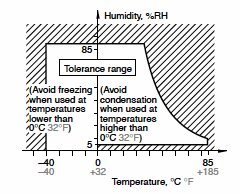 Business
> Industrial Devices
> Automation Controls Top
> Components & Devices
> Relays / Couplers
> /ac/e/control/relay/safety/index.jsp?c=search">Safety Relays
>
> Cautions For Use
Business
> Industrial Devices
> Automation Controls Top
> Components & Devices
> Relays / Couplers
> /ac/e/control/relay/safety/index.jsp?c=search">Safety Relays
>
> Cautions For Use
SF Relays Cautions for Use
1.Coil operating power
Pure DC current should be applied to the coil. The wave form should be rectangular. If it includes ripple, the ripple factor should be less than 5%. However, check it with the actual circuit since the characteristics may be slightly different.
2.Coil connection
When connecting coils, refer to the wiring diagram to prevent mis-operation or malfunction.
3.Cleaning
This relay is not sealed, therefore, immersion may cause failure. Be careful that flux does not overflow onto the PC board or penetrate inside the relay.
4.Soldering
When using automatic soldering, the following conditions are recommended
1) Preheating: 120°C 248°F, within 120
Sec (PC board solder surface)
2) Soldering: 260°C±5°C 500°F±41°F,
within 6 Sec
5.Installation
1) Attach directly to the chassis or use a DIN rail.
- (1) When attaching directly to chassis
· Use a M3.5 screw, spring washer, and hex nut.
· For the mounting pitch, refer to the dimensions. - (2) When installing on a DIN rail
· Use a 35 mm 1.378 inch wide DIN rail (DIN46277).
· Install and remove as shown in the figures below.
|
2) Refer to the figure below for applicable
wire-pressed terminals.
(You cannot use round type wire-pressed
terminals.)
|
6.Other
1) If the relay has been dropped, the appearance and characteristics should always be checked before use.
2) The switching lifetime is defined under the standard test condition specified in the JIS* C 5442-1996 standard (temperature 15 to 35°C 59 to 95°F, humidity 25 to 75%). Check this with the actual product as it is affected by the coil driving circuit, load type, activation frequency, activation phase, ambient conditions and other factors. Also, be especially careful with loads such as those listed below.
- (1) When used for AC load-operation and the operating phase is synchronous. Rocking and fusing can easily occur due to contact shifting.
- (2) During high frequency on/off operation with certain loads, arcing may occur at the contacts. This can cause fusion to Oxygen and Nitrogen gas in the air creating Nitric Acid (HNO3) which can cause corrosion to the contacts.
Please see the following countermeasure examples:
- 1.Incorporate an arc-extinguishing circuit.
- 2.Lower the operating frequency
- 3.Lower the ambient humidity
3) For secure operations, nominal coil voltage should be applied. In addition, please note that pick-up and drop-out voltage will vary according to the ambient temperature and operating conditions.
4) Heat, smoke, and/or fire may occur if the relay is used outside the allowable ranges for the coil ratings, contact ratings, operating cycle lifetime, and other specifications. Therefore, do not use the relay if these ratings are exceeded. Also, make sure that the relay is wired correctly.
5) Incorrect wiring may cause false operation or generate heat or flames.
6) Check the ambient conditions when storing or transporting the relays and devices containing the relays. Freezing or condensation may occur in the relay causing damage. Avoid exposing the relays to heavy loads, or strong shock and vibration.
7.Usage, transport and storage conditions
1) Ambient temperature, humidity, and atmospheric pressure during usage, transport, and storage of the relay:
- (1) Temperature:
–40 to +85°C –40 to +185°F (When the temperature is 70 to 80°C, reduce the 6 A max. switching current by 0.1 A/°C.) - (2) Humidity: 5 to 85% RH (Avoid freezing and condensation.) The humidity range varies with the temperature. Use within the range indicated in the graph below.
- (3) Atmospheric pressure: 86 to 106 kPa Temperature and humidity range for usage, transport, and storage
|
2) Condensation
Condensation forms when there is a
sudden change in temperature under
high temperature and high humidity
conditions. Condensation will cause
deterioration of the relay insulation.
3) Freezing
Condensation or other moisture may
freeze on the relay when the
temperatures is lower than 0°C 32°F. This
causes problems such as sticking of
movable parts or operational time lags.
4) Low temperature and low humidity At low temperature, low humidity environments, the plastic becomes brittle. Please note corrections.
8.Please connect DC coil types with LED and built-in diode correctly by verifying the coil polarity ("+" and "– "). Connecting with reverse polarity will cause the LED not to light and damage the built-in diode due to its specification.
BY EMAIL
- U.S.A.
- +1-800-344-2112
- Europe
- +49-89-45354-1000
- China
- +86-10-59255988
- Singapore
- +65-6299-9181
Requests to customers (Automation Control Components & Industrial Device) [Excluding specific product]
Requests to customers (Automation Control Components & Industrial Device) [For specific product]
Requests to customers (FA Sensors & Components [Excluding motors])
Requests to customers (Dedicated to industrial motors)
- COMPONENTS & DEVICES
- FA SENSORS & COMPONENTS
- Fiber Sensors
- Photoelectric Sensors / Laser Sensors
- Micro Photoelectric Sensors
- Light Curtains / Safety Components
- Area Sensors
- Inductive Proximity Sensors
- Particular Use Sensors
- Sensor Options
- Wire-Saving Systems
- Programmable Controllers / Interface Terminal
- Human Machine Interface
- Pressure Sensors / Flow Sensors
- Measurement Sensors
- Static Control Devices
- Laser Markers / 2D Code Readers
- Machine Vision System
- Energy Management Solutions
- Timers / Counters / FA Components
- MOTORS









